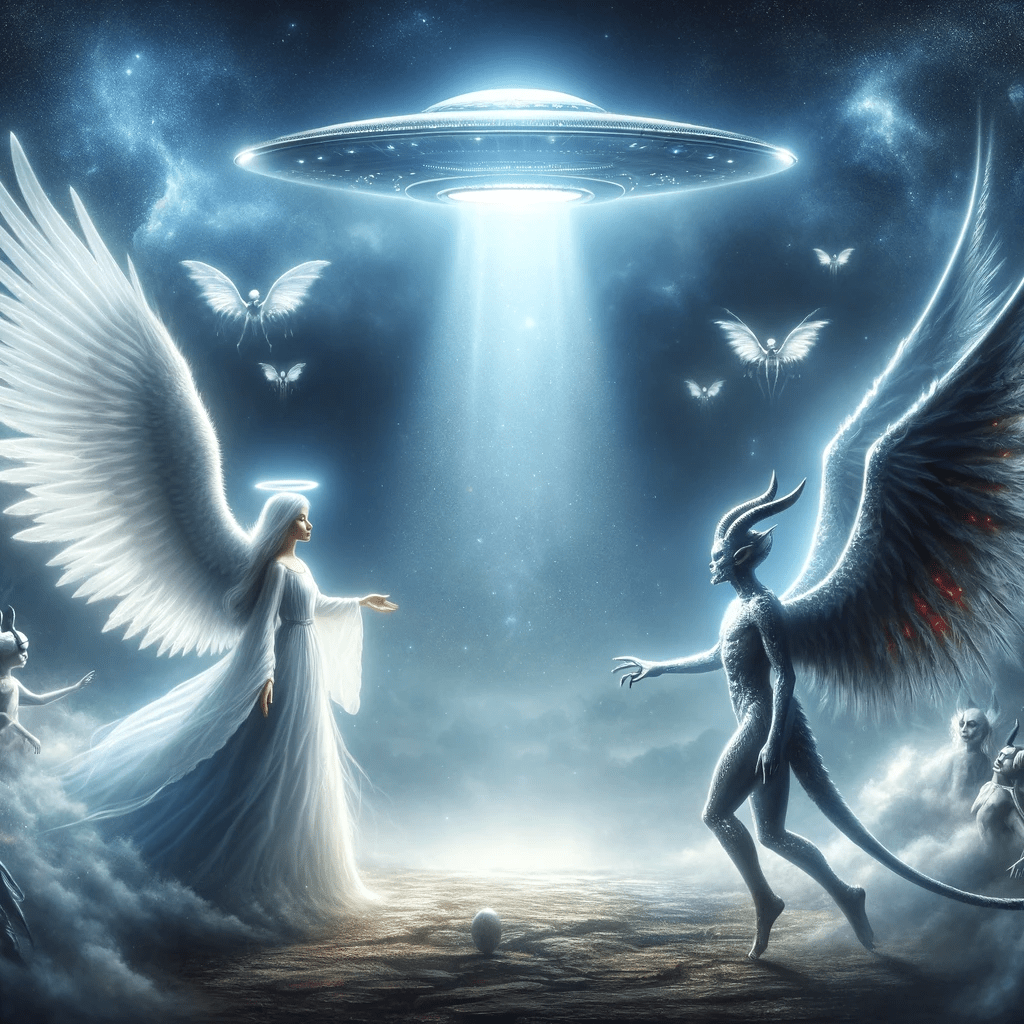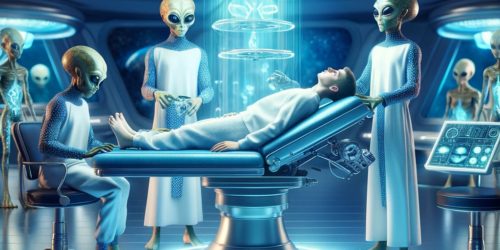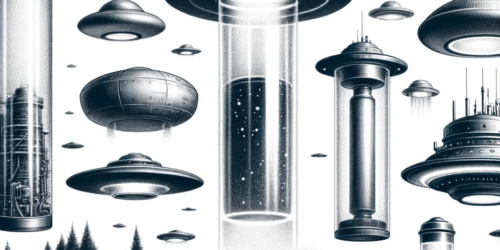Angels and Demons

Some UFO researchers, enthusiasts, and authors have speculated about possible connections between the phenomenon of unidentified flying objects (UFOs) and the concepts of angels and demons. While not universally accepted among UFO experts, these theories suggest that encounters with angels or demons might be related to extraterrestrial visitations or advanced technology. Here are a few examples of books and authors that touch upon this idea:
- Chariots of the Gods (Erich von Däniken): This influential book, published in 1968, popularized the ancient astronaut theory, which posits that extraterrestrials visited Earth in ancient times and were responsible for many of humanity’s early technological and cultural achievements. While von Däniken does not explicitly discuss angels and demons, he suggests that many supernatural beings from ancient myths and religious texts might have been misinterpreted encounters with advanced extraterrestrial beings.
- The Gods of Eden (William Bramley): In this book, Bramley proposes that many religious and mythological figures, including angels and demons, might be linked to an extraterrestrial race he calls the “Custodians.” He argues that these beings have manipulated human history to maintain control over humanity and perpetuate conflict and suffering.
- Passport to Magonia: On UFOs, Folklore, and Parallel Worlds (Jacques Vallée): Vallée, a respected UFO researcher, explores the connections between UFO phenomena, folklore, and mythology in this book. He suggests that some encounters with angels, demons, or other supernatural beings might be related to a broader phenomenon that includes UFOs, and that these experiences may be shaped by cultural and psychological factors.
- Angels and Aliens: UFOs and the Mythic Imagination (Keith Thompson): Thompson’s book looks into the mythic and symbolic aspects of UFO encounters, discussing how they may relate to traditional stories of angels, demons, and other supernatural beings. He proposes that both UFO experiences and encounters with angels or demons may reflect deep-seated human needs for meaning and transcendence.
While these books and authors offer intriguing perspectives on the potential connections between UFOs and angels or demons, it is important to note that these ideas remain speculative and are not universally accepted within the UFO research community.
John A. Keel’s views on Angels and Demons
John A. Keel’s views on angels and demons were closely tied to his overall theories about the nature of UFOs and paranormal phenomena. He believed that these entities, often described in religious and mythological texts, might be manifestations of the same supernatural or interdimensional beings that he referred to as “ultraterrestrials.”
Keel argued that these entities could be responsible for a wide range of unexplained phenomena, such as UFO sightings, apparitions, and other mysterious events. He believed that they could manipulate the physical world and human perception, often appearing in ways that were meaningful or relevant to the individual observer. This could explain why sightings and encounters often seemed to involve elements of the witness’s culture or personal beliefs.
Keel was particularly interested in the possibility that these beings might have motives or agendas that were beyond human comprehension. He speculated that they could be influencing human behavior, shaping our beliefs, and even guiding the course of human history for reasons we may never fully understand.
The Bible views on Angels and Demons
The Bible presents a complex and diverse view of angels and demons throughout both the Old and New Testaments. It is important to note that interpretations of these concepts can vary depending on religious beliefs and denominations. However, we can identify some common themes and understandings.
Angels: Angels are often portrayed as supernatural beings created by God to serve as messengers or agents. They are usually depicted as benevolent, powerful, and obedient to God’s will. Some of the primary roles angels play in the Bible include:
- Messengers: Angels are frequently sent to deliver important messages from God to humans (e.g., the angel Gabriel appearing to Mary in Luke 1:26-38).
- Protectors: Angels are depicted as protectors or guardians of individuals or nations (e.g., the angel of the Lord protecting Israel in Exodus 14).
- Worshipers: Angels are often shown praising and worshiping God in heaven (e.g., Revelation 4:8-11).
- Executors of God’s will: Angels may be sent to carry out specific tasks or judgments, such as the destruction of Sodom and Gomorrah in Genesis 19.
Demons: Demons, on the other hand, are generally depicted as malevolent, supernatural beings opposed to God and His purposes. They are often associated with Satan or the devil, who is portrayed as a fallen angel and the leader of the demonic realm. In the Bible, demons are presented as:
- Tempters: Demons are shown trying to lead humans away from God and into sin, as when Satan tempts Jesus in the wilderness (Matthew 4:1-11).
- Oppressors: Demons are depicted as causing suffering, torment, and possession in the lives of people, as in the numerous accounts of Jesus casting out demons from afflicted individuals (e.g., Mark 1:21-28).
- Deceivers: Demons are said to be capable of spreading false teachings and leading people astray, as warned by Paul in 1 Timothy 4:1.
The battle between angels and demons in the Bible can be seen as part of the broader spiritual conflict between good and evil, or God’s kingdom and the forces opposed to it. Although there are numerous accounts of both angels and demons in the Bible, it is important to remember that these are just a few examples, and interpretations can vary widely.
Throughout history, various literary works have explored the topic of angels and demons, drawing from religious, mythological, or cultural sources. Here is a list of some important pieces of literature that discuss these supernatural beings:
- The Divine Comedy (Dante Alighieri): This epic 14th-century poem is divided into three parts: Inferno, Purgatorio, and Paradiso. It follows the journey of the poet Dante through Hell, Purgatory, and Heaven, guided by the Roman poet Virgil and later by Beatrice. Throughout the journey, Dante encounters various angels and demons, providing vivid descriptions and allegorical insights.
- Paradise Lost (John Milton): This 17th-century epic poem in English retells the Biblical story of the fall of humanity, focusing on the characters of Satan, the rebellious angel, and Adam and Eve. Milton’s depiction of angels and demons in this work has been influential in shaping later interpretations of these beings in literature and popular culture.
- Faust (Johann Wolfgang von Goethe): Faust is a two-part tragic play written in the late 18th and early 19th centuries. The story revolves around the character of Faust, who makes a deal with the demon Mephistopheles in exchange for knowledge and worldly pleasures. The play explores themes of temptation, sin, and redemption, with angels and demons playing key roles in the narrative.
- The Screwtape Letters (C.S. Lewis): This Christian apologetic novel, published in 1942, is presented as a series of letters written by a senior demon, Screwtape, to his nephew Wormwood, a junior tempter. The letters provide advice on how to lead a human away from God and toward sin. The novel offers an imaginative and satirical take on the workings of demonic forces in the lives of humans.
- The Mortal Instruments series (Cassandra Clare): This is a young adult fantasy series in which the main characters, known as Shadowhunters, fight demons and protect humanity. The series features various angels and demons, drawing from both Biblical and mythological sources.
- The Book of Enoch: This ancient Jewish apocalyptic text, not included in the Christian Biblical canon, contains detailed descriptions of angels, both good and evil, and their interactions with humans. It is particularly significant for its account of the “Watchers,” fallen angels who corrupted humanity before the Great Flood.
- Summa Theologica (Thomas Aquinas): This influential theological work by the 13th-century philosopher and theologian Thomas Aquinas contains a section on angels and demons, known as the “Treatise on Angels.” Aquinas provides a systematic examination of the nature, attributes, and activities of these beings, drawing from Christian scripture and the works of earlier philosophers.
- The Infernal Dictionary (Jacques Collin de Plancy): This 19th-century book is a compendium of demonology and occult lore, providing descriptions and illustrations of various demons, as well as information on rituals, superstitions, and beliefs related to demonic forces.
- Many Sides of Angels and Demons (Rudolf Steiner): The Austrian philosopher, social reformer, and founder of anthroposophy, Rudolf Steiner, discusses angels and demons from a spiritual and esoteric perspective. He describes the roles these beings play in the spiritual development of humanity and their connection to broader cosmic forces.
- Angels and Demons (Dan Brown): While this novel is a work of fiction, it has gained widespread popularity and sparked interest in the subject of angels and demons. The story follows symbologist Robert Langdon as he investigates a secret society called the Illuminati and uncovers a conspiracy involving the Vatican.
Here are some perspectives from various experts:
- Theologians and religious scholars: Many theologians and religious scholars study angels and demons within the context of specific religious texts and traditions. Their interpretations and understandings of these beings are often shaped by the teachings of their faith, as well as historical and cultural factors. They may focus on the roles that angels and demons play in religious narratives, the nature of their existence, and the moral or spiritual lessons derived from these stories.
- Historians: Historians may examine the belief in angels and demons as a reflection of cultural, social, or religious developments over time. They might explore how these beliefs have changed or persisted across different civilizations, and the ways they have influenced art, literature, and other aspects of human culture.
- Psychologists and anthropologists: Some experts in psychology and anthropology study angels and demons from a human behavior perspective. They may consider these beings as symbolic representations of human emotions, desires, and fears, or as expressions of collective unconscious archetypes. Such experts might analyze the psychological and social functions that beliefs in angels and demons serve, such as providing a sense of order, meaning, or moral guidance.
- Folklorists and mythologists: These experts study the roles that angels and demons play in myths, legends, and folktales from various cultures. They may analyze the similarities and differences in the portrayal of these supernatural beings across different traditions, and explore the underlying themes or motifs that connect these stories.
- Philosophers: Some philosophers engage with the concept of angels and demons from a metaphysical or ethical standpoint. They might explore questions related to the nature of good and evil, the existence of a spiritual realm, or the moral implications of belief in supernatural beings.
- Scientists and skeptics: Many scientists and skeptics approach the subject of angels and demons from a rational or empirical perspective. They may question the existence of these beings and argue that beliefs in angels and demons can be explained by natural phenomena, psychological factors, or cultural influences, rather than supernatural causes.
Experts from various fields have different perspectives on angels and demons, depending on their area of expertise and personal beliefs. Some may focus on the religious, historical, or cultural aspects of these beings, while others may engage with the psychological, philosophical, or scientific dimensions of the topic. As a result, there is a wide range of opinions and interpretations when it comes to angels and demons.



